When you first buy a pontoon boat, you might not necessarily think too much about how powerful the engine and motor should be. After all, most first-time buyers are looking for something that’s going to let them fish and take family out for some leisure time.
However, the engine horsepower should be an important consideration, as it can impact on how and when you use your boat – for example, will you be able to pull a tube behind it?
As a general rule of thumb, the more horsepower and speed you go for, the more money you are going to have to spend. I would always advise you get as much horsepower as you can afford, as it will help future proof you with any activities you might not yet be planning on doing with your pontoon boat such as tubing and skiing.
But, even if you do have a lower range horsepower engine, that might not stop you from getting more speed out of your boat. If you want to make your pontoon faster and eke out some additional speed so you can pull skiers and tubers faster, then the tips below will help you in doing that.
So, if you do want to know how to make your pontoon boat faster, then please read these 13 tips. By implementing some or all of them, you will soon be able to get better speeds from your engine, no matter what the horsepower.
Tip 1: Trim Your Engine
This is one of the more common tasks you can perform to get improved speed and is actually relatively simple to do. It can give you some amazing results if done properly. How? Next time you’re out on the water, open the throttle up and see what happens.
Do you get a lot of water splashing up under the boat and between the tubes? Does it feel like your logs are plowing through the water and struggling a little bit?
If you answer yes to either of these questions then you can trim your engine, and it should make a difference to speed.
When you use the trim, trimming will tilt your boat engine to a higher angle. It does this with a little hydraulic motor which will raise the boat’s front out of the water a little. This will give you improved performance.
Tip 2: Keep Your Tubes Clean
If you keep your pontoon tubes clean from debris and scum, with smoother surfaces, you will reduce the drag on your boat and get faster speeds.
This will increase the laminar flow of water around the boat, as there won’t be as much obstruction for a smoother glide through the water.
If you need any tips on how to do so, then I recommend reading these tips on how to clean off algae and my guide on how to polish your pontoons for an ultra-smooth finish.
Tip 3: Change Your Pontoon Boat’s Thrust
By changing your pontoon boat’s thrust you can get faster speeds. Increase the thrust you have available by tuning the motor. By doing so you can get increased horse power (hp) but would probably need the services of a marine mechanic if you aren’t mechanically minded.
If this tuning doesn’t have the required speed result you may want to consider buying a new more high-powered engine that produces more horse power – but be aware, there could be a legal limit on how high you can due to your boat size. Check the capacity plate to see the limits set by the manufacturer.
Tip 4: Change Your Boat’s Lift
To further reduce drag on your pontoon as it runs through the water, you can change the lift. How? You can achieve this by switching from displacement pontoon tubes to planing pontoon tubes.
Pontoon boats come with displacement hulls which push their way through the water. There have been recent changes in technology where it’s now possible to buy planing hulls for pontoon boats, which are zero-displacement – in other words they have minimal contact with the water. They run on top of the water’s surface rather than on top of it. It’s an expensive switch though!
Tip 5: Reduce the Weight on Your Boat
It’s so obvious but might actually give you the best result if you want your pontoon to run quicker through the water when pulling.
As an example, let’s say you’re pulling water skiers behind your pontoon boat, and want to get faster speeds to actually make it worthwhile. In this case I would drop any additional passengers back to shore, and only have the captain and spotter on the boat.
You should also remove any excess weight from the boat, and I will get a little more specific on some more of those tips a little further on.
Tip 6: Fit Lifting Strakes
You might have to spend a couple of thousand dollars but lifting strakes can go a long way when it comes to making your pontoon boat faster. If you don’t know what they are, go read this guide telling you all you need to know.
In simple terms though, lifting strakes are a piece of metal under the boat. It helps the pontoon get onto a plane instead of plowing through the water and slowing down.
Lifting strakes will often come as a feature on newer pontoons, but some boat owners will retrospectively fit them to their boat to achieved faster speeds.
Tip 7: Convert Your Pontoon to a Tritoon
Add a third tube or log to the middle of your pontoon, and you will now have a tritoon. Tritoons are pontoons that have 3 tubes instead of 2. You can find out more about them by reading this guide on pontoons versus tritoons.
It will cost a lot of money, with typical prices being around $4,000 (as of 2017). By adding a third tube, your pontoon boat will go faster, and have visible increased performance.
My advice to people considering this is to actually just buy a purpose-built tritoon. It will save you a lot of hassle, and might be more economical in the long run if you trade your existing boat in.
Tip 8: Don’t Fill Up Completely on Fuel
Earlier I spoke about weight and promised some additional tips. One weight reduction aspect often overlooked is how much gas is in the tank.
With gas weighing 8 pounds per gallon, that can mean 200 pounds of weight on the boat if you’ve filled up a standard 25-gallon tank. To put that into some form of visual perspective, it’s like having an extra passenger on board.
If you can get away with just filling your tank up with 50% of fuel, with no concerns for running out at any point, then you can dramatically reduce the weight of your boat, and therefore the drag performance over the water.
Tip 9: Distribute the Weight Better
I’ve spoken a lot about weight causing drag already, but there’s another aspect here, which concerns the placement of weight in your pontoon.
Putting more weight towards the read of the boat will increase your speed and make you go faster as it will help to lift up the boat. As we’ve already discussed, lift is one of the essential keys to improving you speed. More weight at the back will lift the front of the boat, stopping it from plowing through the water and slowing you down.
Tip 10: Underskin Your Pontoon
With this custom job you’ve looking to spend around $500. It involves the addition of metal sheets underneath the deck, which makes the underside smoother.
When water splashes up underneath the boat, it hits the metal studs that support the deck, which can cause drag. With underskinning, you’ve instead got smoother metal under there which will reduce the drag and make you go a little bit faster.
How much faster?
In my experience, not a lot. But you might get an extra 2 miles per hour once the underskinning has been installed. It’s a lot of money to spend for what in reality is only a marginal gain in speed.
Tip 11: Buy a Booster Ball
I hadn’t heard of these until last month when I saw another pontooner using one. It won’t make your boat go faster, but it will increase the speed and enjoyment for the skiers and tubers being pulled behind.
Why? Because this inflatable ball fits into the middle of the tow rope and keeps it from going under the water. What that then does is keep the tuber outside of the wake, giving them a far better thrill ride.
You can buy a Booster Ball on Amazon. Take a look at the reviews and spec to see more, it’s a really ingenious invention. The rope line will be above the water, meaning the tuber or skier will feel like they are on a far quicker boat.
Tip 12: Buy a Raised & Mounted Ski Harness
Another way in which you can get better results when skiing or tubing is to use a raised ski harness. Again, it won’t make your pontoon boat faster or quicker, but will improve the experience of the person being pulled behind.
It has the same effect as the ball booster shown above, but actually works even better as the line is kept very high and raised to ensure there’s zero water drag.
Tip 13: And Finally, Go Downwind
I can’t honestly believe I am saying this, but you would be amazed at how many pontooners I see trying to pull tubes and skier into the wind.
This one simple trick will mean your boat will go faster, and you will be pulling them a lot quicker. It’s so obvious, but so often overlooked.
Final Thoughts
Your pontoon boat’s speed is operating in two different fluids; not just water, but also air. Whilst your tubes will be moving through the single water fluid, it will also be affected by air, just like an airplane is.
The factors that help it pick up and maintain speed include the engine power (the thrust), the planing ability of the tubes (the lift), and how the tubes intersect with the water (the drag). Without getting too scientific, if you can maximise these elements and how they interact with the water and air, you are going to get improved speed.
That will include focusing on the hull to get increased lift, looking at the power to minimise drag in the water, and addressing any weight issues in the boat.
With that in mind, the tips above include some mechanical changes you can make, but also some other factors. I hope that they help!
Handy Hint: Here is a guide to pontoon boat speeds including how fast standard ones can go.






